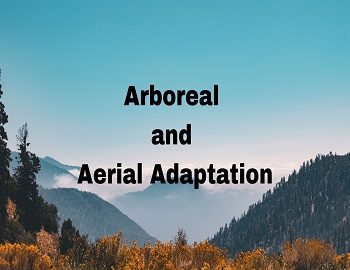Arboreal and Aerial Adaptation:
The tree-dwelling is called arboreal habit and is found in lizards, flying fox (Pteropus), bat, Loris, monkeys and squirrels. Chameleon is a well-adapted among the arboreal lizards. The chief adaptations of arboreal animals are the following-
- Since climbing the tree is a movement against gravity and is a strenuous activity so the body size of arboreal animals tends to be reduced. Example- Opossums, phalangers, koalas and squirrels.
- The pentadactyle quadrupedal (five-digits and four-leged) body form is most suitable for the arboreal mode of life.
- Claws occur in lizards, birds and mammals. Bats have sharp recurved claws both on their wings and on their hind feet. In birds, the digits are particularly strong in parrots and woodpeckers.
- They have a strong body with a well-developed pectoral girdle which supports the weight of the body.
- Hip or pelvic girdle is broad as it has to support the body organs.
- The modifications undergone by the limbs include lengthening of bones, development of strong muscles and the evolution of the catching and holding mechanisms. The underside of feet is provided with pads which contribute to the effectiveness of the grip and prevent slipping.
- The tail may be either prehensile (capable of grasping) as is found in chameleons and in some monkeys or has hairs and scales to prevent the animal from slipping as in flying squirrel.
The aerial (or volant or flying) adaptations are shown by insects and birds. Birds fly smoothly in the air as they have a light, streamlined body covered with feathers, forelimbs modified into wings, compact bones provided with air cavities and lungs connected with air-sacs.
- Mitosis: Process and Significance
- Meiosis: Process and Significance
- Respiratory organs present in human being
- Mechanism Of Urine Formation In Human
- Thyroid Gland And Important Hormones And Deficiency Disorder
- Essential and Non-essential Parts of the Flowers
- Difference Between C3 Plants And C4 Plants
- Body Fluids and Circulation









Comments (No)